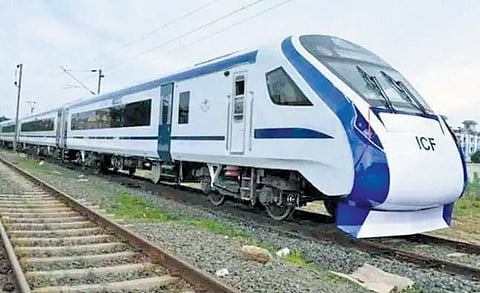

While the introduction of Vande Bharat Express trains in Kerala is a welcome move, comparing the same with SilverLine is futile. The proposed SilverLine project is a modern rail infrastructure with the capacity to carry more than 10 lakh passengers a day. The Vande Bharat is an indigenously developed modern train capable to hitting top speeds of 160 kmph.
In 2015, the central cabinet decided to involve state governments in railway infrastructure development and decided to form joint venture (JV) companies. These state JVs will identify rail projects that are required for that particular state in accordance with the aspirations of the people of the state. Kerala was one of the first states to form a JV company -- the Kerala Rail Development Corporation Ltd (K-Rail/KRDCL) was formed in 2017.
After the formation of K-Rail, discussions started on various rail projects at various levels. Based on a meeting between Chief Minister Pinarayi Vijayan and the chairman of the Railway Board, it was decided to construct two additional lines between Thiruvananthapuram and Kasaragod, since the existing double line is fully saturated and there is a persistent demand for more trains, and that too faster trains. It was also deemed necessary that the additional two lines follow a semi-high-speed alignment.
SilverLine is a modern rail infrastructure -- a 529.45km-long greenfield corridor -- with track, signalling, electrical traction systems, etc, that will allow trains to run at 220 kmph. It will have 74 trains running in both directions at an interval of 20 minutes during peak hours. On peak days it will have the capacity to carry more than 10 lakh passengers by running trains at five-minute intervals.
Based on the feasibility report submitted to the railway ministry in 2019, in-principle approval was granted for taking up pre-investment activities. Following this approval, the detailed project report (DPR) was prepared by KRDCL with the help of Systra and forwarded to the ministry in 2020. As per the DPR, the project will cost `63,941 crore.
SilverLine will allow passengers to travel from Thiruvananthapuram to Kasaragod in four hours. It is designed to address the inadequacy of the existing rail transport and to strengthen public transportation in the state. Nearly 50,000 people will be directly and indirectly employed during construction and around 11,000 during the operation phase of the project. According to our estimates, 46,206 road users per day will move to SilverLine to begin with. With 12,872 vehicles off the road in the first year, traffic congestion will be significantly reduced. In addition, it will save Rs 530 crore on petrol and diesel every year.
The SilverLine track, which is designed to avoid sharp curves, passes through relatively sparsely populated areas. The 137km-long track will also contain overpasses, tunnels and viaducts so that there are no restrictions to freedom of movement. Moreover, there will be footpaths and overpasses every 500m to facilitate crossings.
There have been a lot of discussions and comparisons between Vande Bharat and SilverLine. It is important to note that the broad-gauge rail infrastructure in Kerala is not adequate to run Vande Bharat trains, which can run at 160 kmph. Moreover, comparing a modern rail transportation system with the capacity to carry more than 10 lakh passengers a day with a single train may not be the right way to take these forward.
SilverLine is essential to accelerate all-around development of the state economy and boost GDP. It can create business and employment opportunities, and ensure transit-oriented development. The fast and safe mode of transportation can reduce traffic accidents and congestion. The existing rail infrastructure in Kerala is not enough to meet even current demand and the additional two lines, in whatever form, will be required to meet the future rail travel requirements of the state.
(Author is managing director of the Kerala Rail Development Corporation)